Heriot-Watt University: Clay-Based Mortars in Construction (D38TA)
VerifiedAdded on 2023/05/28
|21
|5466
|389
Report
AI Summary
This report provides a comprehensive analysis of clay-based mortars as a construction material, exploring their advantages, disadvantages, and applications in modern construction. It begins by defining mortar and soil, highlighting the significance of mortar in masonry. The report then delves into the benefits of clay-based mortars, such as their economic viability, energy efficiency, and environmental sustainability, while also acknowledging limitations like reduced strength and structural restrictions. A problem statement addresses the need for sustainable alternatives to concrete, leading to the report's scope and objective of demonstrating the relevance of clay-based mortars in contemporary construction. A literature review covers the historical use of clay-based mortars and examines their properties in both fresh and hardened states, including workability, water retention capacity, and air content. The report references various studies and examples, such as the use of clay-based mortars in ancient structures and the town of Malton, North Yorkshire, to illustrate their practical application and durability.
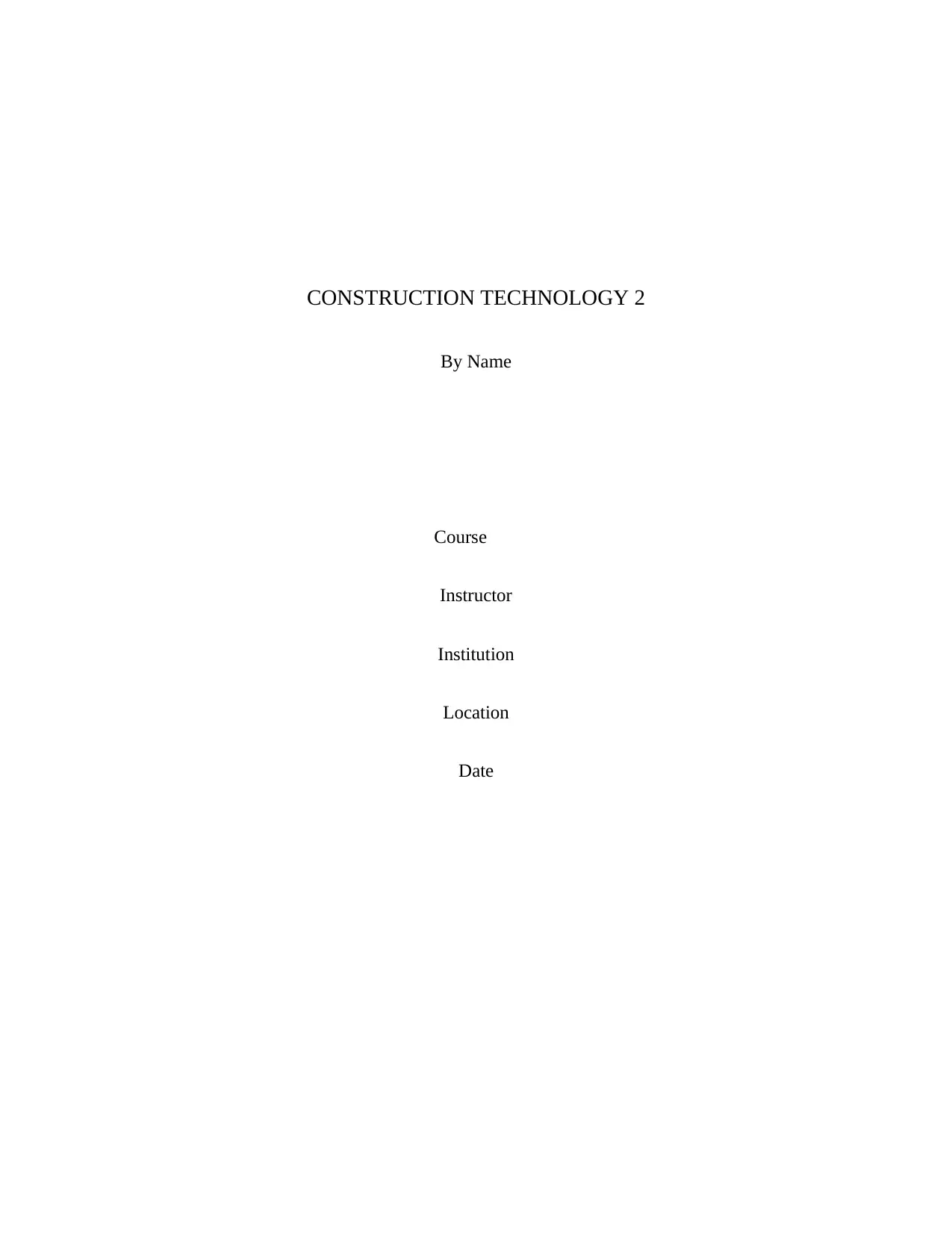
CONSTRUCTION TECHNOLOGY 2
By Name
Course
Instructor
Institution
Location
Date
By Name
Course
Instructor
Institution
Location
Date
Paraphrase This Document
Need a fresh take? Get an instant paraphrase of this document with our AI Paraphraser
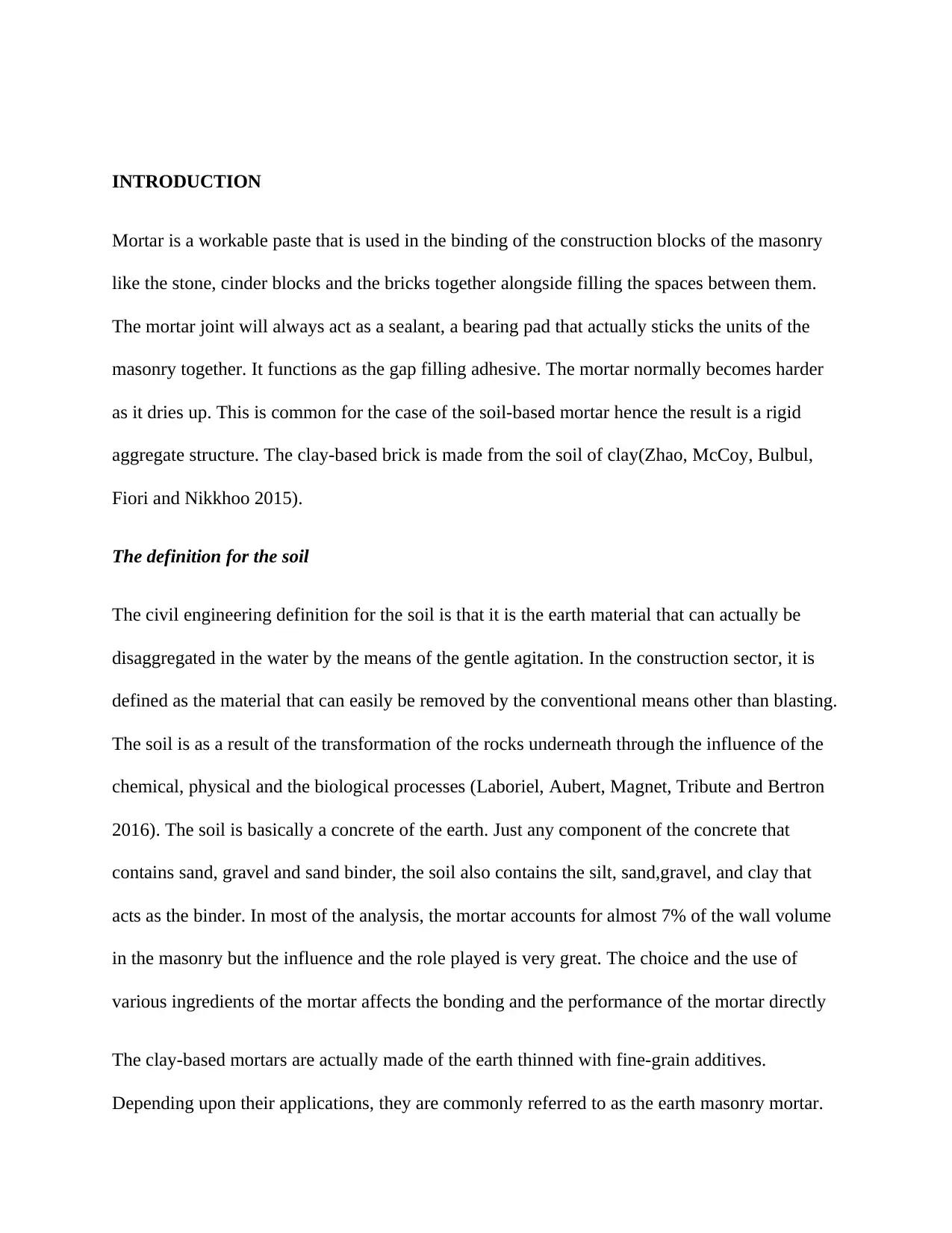
INTRODUCTION
Mortar is a workable paste that is used in the binding of the construction blocks of the masonry
like the stone, cinder blocks and the bricks together alongside filling the spaces between them.
The mortar joint will always act as a sealant, a bearing pad that actually sticks the units of the
masonry together. It functions as the gap filling adhesive. The mortar normally becomes harder
as it dries up. This is common for the case of the soil-based mortar hence the result is a rigid
aggregate structure. The clay-based brick is made from the soil of clay(Zhao, McCoy, Bulbul,
Fiori and Nikkhoo 2015).
The definition for the soil
The civil engineering definition for the soil is that it is the earth material that can actually be
disaggregated in the water by the means of the gentle agitation. In the construction sector, it is
defined as the material that can easily be removed by the conventional means other than blasting.
The soil is as a result of the transformation of the rocks underneath through the influence of the
chemical, physical and the biological processes (Laboriel, Aubert, Magnet, Tribute and Bertron
2016). The soil is basically a concrete of the earth. Just any component of the concrete that
contains sand, gravel and sand binder, the soil also contains the silt, sand,gravel, and clay that
acts as the binder. In most of the analysis, the mortar accounts for almost 7% of the wall volume
in the masonry but the influence and the role played is very great. The choice and the use of
various ingredients of the mortar affects the bonding and the performance of the mortar directly
The clay-based mortars are actually made of the earth thinned with fine-grain additives.
Depending upon their applications, they are commonly referred to as the earth masonry mortar.
Mortar is a workable paste that is used in the binding of the construction blocks of the masonry
like the stone, cinder blocks and the bricks together alongside filling the spaces between them.
The mortar joint will always act as a sealant, a bearing pad that actually sticks the units of the
masonry together. It functions as the gap filling adhesive. The mortar normally becomes harder
as it dries up. This is common for the case of the soil-based mortar hence the result is a rigid
aggregate structure. The clay-based brick is made from the soil of clay(Zhao, McCoy, Bulbul,
Fiori and Nikkhoo 2015).
The definition for the soil
The civil engineering definition for the soil is that it is the earth material that can actually be
disaggregated in the water by the means of the gentle agitation. In the construction sector, it is
defined as the material that can easily be removed by the conventional means other than blasting.
The soil is as a result of the transformation of the rocks underneath through the influence of the
chemical, physical and the biological processes (Laboriel, Aubert, Magnet, Tribute and Bertron
2016). The soil is basically a concrete of the earth. Just any component of the concrete that
contains sand, gravel and sand binder, the soil also contains the silt, sand,gravel, and clay that
acts as the binder. In most of the analysis, the mortar accounts for almost 7% of the wall volume
in the masonry but the influence and the role played is very great. The choice and the use of
various ingredients of the mortar affects the bonding and the performance of the mortar directly
The clay-based mortars are actually made of the earth thinned with fine-grain additives.
Depending upon their applications, they are commonly referred to as the earth masonry mortar.
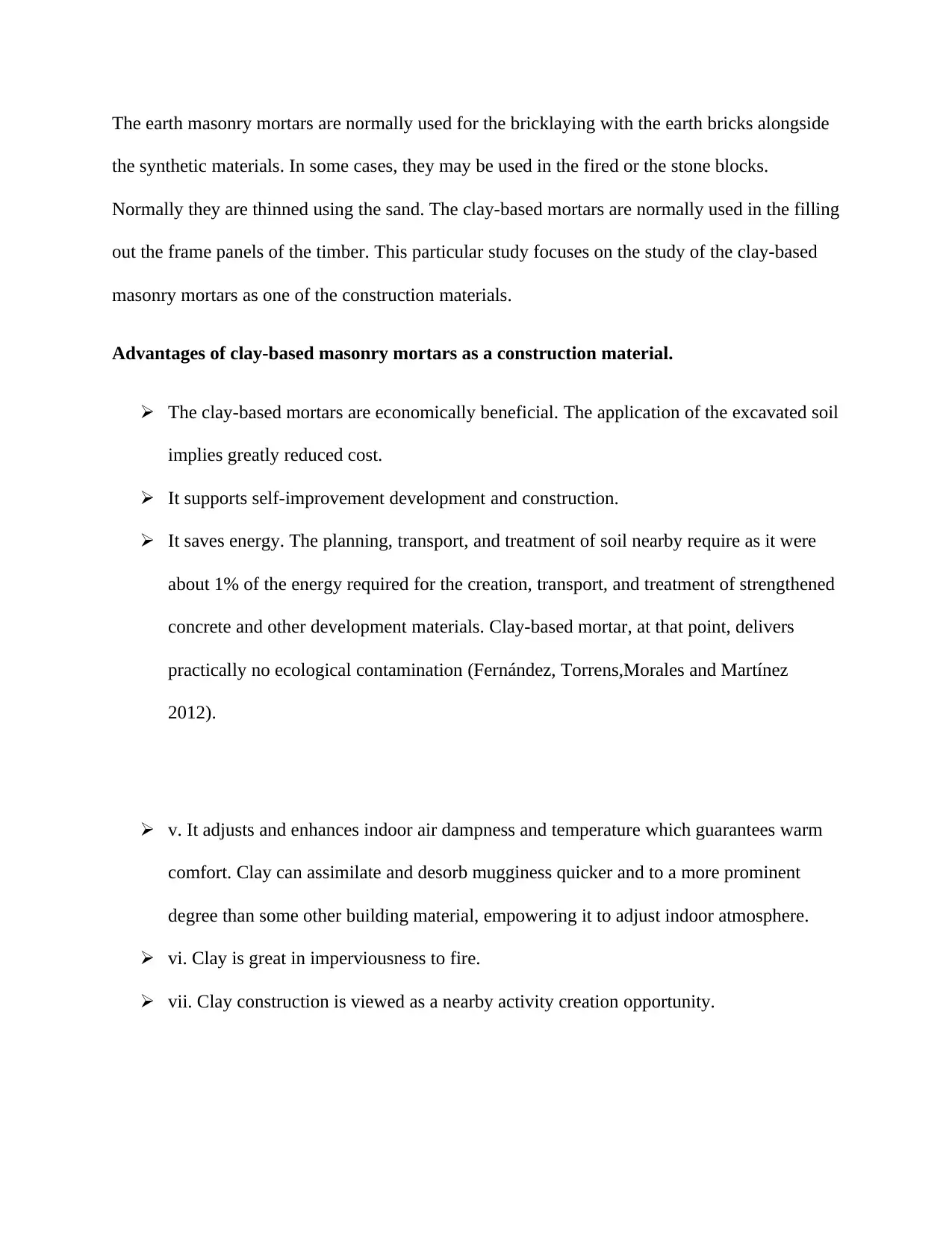
The earth masonry mortars are normally used for the bricklaying with the earth bricks alongside
the synthetic materials. In some cases, they may be used in the fired or the stone blocks.
Normally they are thinned using the sand. The clay-based mortars are normally used in the filling
out the frame panels of the timber. This particular study focuses on the study of the clay-based
masonry mortars as one of the construction materials.
Advantages of clay-based masonry mortars as a construction material.
The clay-based mortars are economically beneficial. The application of the excavated soil
implies greatly reduced cost.
It supports self-improvement development and construction.
It saves energy. The planning, transport, and treatment of soil nearby require as it were
about 1% of the energy required for the creation, transport, and treatment of strengthened
concrete and other development materials. Clay-based mortar, at that point, delivers
practically no ecological contamination (Fernández, Torrens,Morales and Martínez
2012).
v. It adjusts and enhances indoor air dampness and temperature which guarantees warm
comfort. Clay can assimilate and desorb mugginess quicker and to a more prominent
degree than some other building material, empowering it to adjust indoor atmosphere.
vi. Clay is great in imperviousness to fire.
vii. Clay construction is viewed as a nearby activity creation opportunity.
the synthetic materials. In some cases, they may be used in the fired or the stone blocks.
Normally they are thinned using the sand. The clay-based mortars are normally used in the filling
out the frame panels of the timber. This particular study focuses on the study of the clay-based
masonry mortars as one of the construction materials.
Advantages of clay-based masonry mortars as a construction material.
The clay-based mortars are economically beneficial. The application of the excavated soil
implies greatly reduced cost.
It supports self-improvement development and construction.
It saves energy. The planning, transport, and treatment of soil nearby require as it were
about 1% of the energy required for the creation, transport, and treatment of strengthened
concrete and other development materials. Clay-based mortar, at that point, delivers
practically no ecological contamination (Fernández, Torrens,Morales and Martínez
2012).
v. It adjusts and enhances indoor air dampness and temperature which guarantees warm
comfort. Clay can assimilate and desorb mugginess quicker and to a more prominent
degree than some other building material, empowering it to adjust indoor atmosphere.
vi. Clay is great in imperviousness to fire.
vii. Clay construction is viewed as a nearby activity creation opportunity.
⊘ This is a preview!⊘
Do you want full access?
Subscribe today to unlock all pages.

Trusted by 1+ million students worldwide
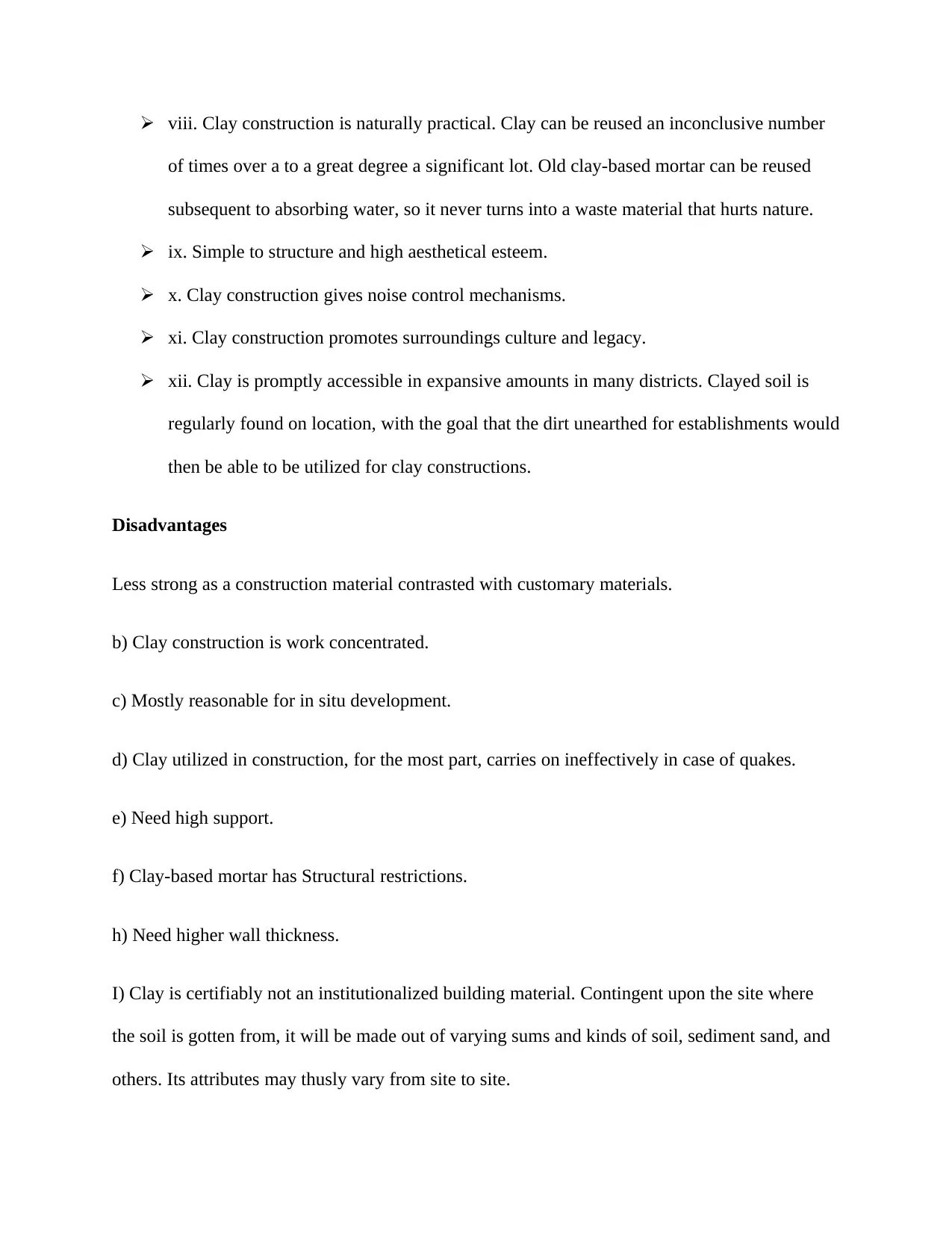
viii. Clay construction is naturally practical. Clay can be reused an inconclusive number
of times over a to a great degree a significant lot. Old clay-based mortar can be reused
subsequent to absorbing water, so it never turns into a waste material that hurts nature.
ix. Simple to structure and high aesthetical esteem.
x. Clay construction gives noise control mechanisms.
xi. Clay construction promotes surroundings culture and legacy.
xii. Clay is promptly accessible in expansive amounts in many districts. Clayed soil is
regularly found on location, with the goal that the dirt unearthed for establishments would
then be able to be utilized for clay constructions.
Disadvantages
Less strong as a construction material contrasted with customary materials.
b) Clay construction is work concentrated.
c) Mostly reasonable for in situ development.
d) Clay utilized in construction, for the most part, carries on ineffectively in case of quakes.
e) Need high support.
f) Clay-based mortar has Structural restrictions.
h) Need higher wall thickness.
I) Clay is certifiably not an institutionalized building material. Contingent upon the site where
the soil is gotten from, it will be made out of varying sums and kinds of soil, sediment sand, and
others. Its attributes may thusly vary from site to site.
of times over a to a great degree a significant lot. Old clay-based mortar can be reused
subsequent to absorbing water, so it never turns into a waste material that hurts nature.
ix. Simple to structure and high aesthetical esteem.
x. Clay construction gives noise control mechanisms.
xi. Clay construction promotes surroundings culture and legacy.
xii. Clay is promptly accessible in expansive amounts in many districts. Clayed soil is
regularly found on location, with the goal that the dirt unearthed for establishments would
then be able to be utilized for clay constructions.
Disadvantages
Less strong as a construction material contrasted with customary materials.
b) Clay construction is work concentrated.
c) Mostly reasonable for in situ development.
d) Clay utilized in construction, for the most part, carries on ineffectively in case of quakes.
e) Need high support.
f) Clay-based mortar has Structural restrictions.
h) Need higher wall thickness.
I) Clay is certifiably not an institutionalized building material. Contingent upon the site where
the soil is gotten from, it will be made out of varying sums and kinds of soil, sediment sand, and
others. Its attributes may thusly vary from site to site.
Paraphrase This Document
Need a fresh take? Get an instant paraphrase of this document with our AI Paraphraser
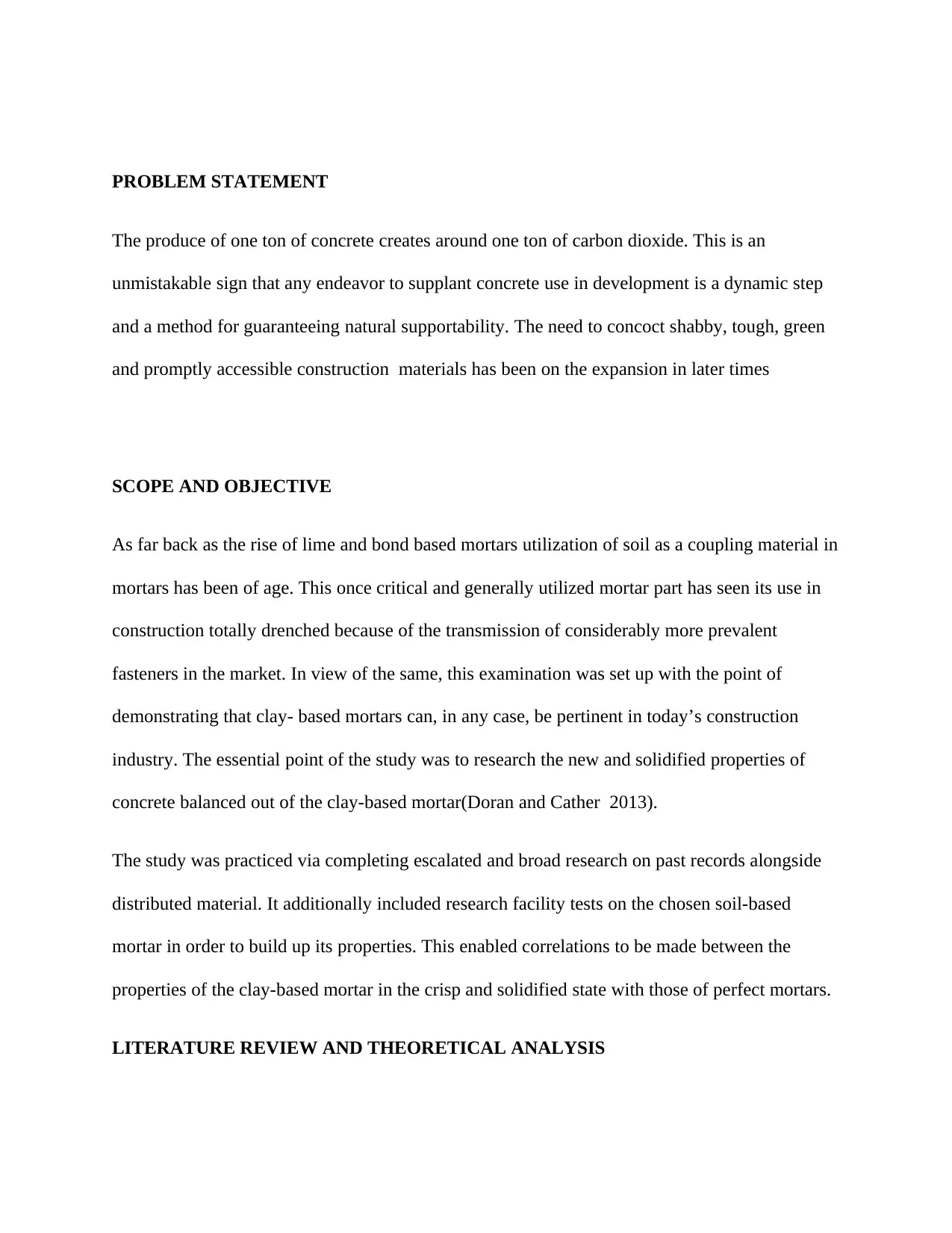
PROBLEM STATEMENT
The produce of one ton of concrete creates around one ton of carbon dioxide. This is an
unmistakable sign that any endeavor to supplant concrete use in development is a dynamic step
and a method for guaranteeing natural supportability. The need to concoct shabby, tough, green
and promptly accessible construction materials has been on the expansion in later times
SCOPE AND OBJECTIVE
As far back as the rise of lime and bond based mortars utilization of soil as a coupling material in
mortars has been of age. This once critical and generally utilized mortar part has seen its use in
construction totally drenched because of the transmission of considerably more prevalent
fasteners in the market. In view of the same, this examination was set up with the point of
demonstrating that clay- based mortars can, in any case, be pertinent in today’s construction
industry. The essential point of the study was to research the new and solidified properties of
concrete balanced out of the clay-based mortar(Doran and Cather 2013).
The study was practiced via completing escalated and broad research on past records alongside
distributed material. It additionally included research facility tests on the chosen soil-based
mortar in order to build up its properties. This enabled correlations to be made between the
properties of the clay-based mortar in the crisp and solidified state with those of perfect mortars.
LITERATURE REVIEW AND THEORETICAL ANALYSIS
The produce of one ton of concrete creates around one ton of carbon dioxide. This is an
unmistakable sign that any endeavor to supplant concrete use in development is a dynamic step
and a method for guaranteeing natural supportability. The need to concoct shabby, tough, green
and promptly accessible construction materials has been on the expansion in later times
SCOPE AND OBJECTIVE
As far back as the rise of lime and bond based mortars utilization of soil as a coupling material in
mortars has been of age. This once critical and generally utilized mortar part has seen its use in
construction totally drenched because of the transmission of considerably more prevalent
fasteners in the market. In view of the same, this examination was set up with the point of
demonstrating that clay- based mortars can, in any case, be pertinent in today’s construction
industry. The essential point of the study was to research the new and solidified properties of
concrete balanced out of the clay-based mortar(Doran and Cather 2013).
The study was practiced via completing escalated and broad research on past records alongside
distributed material. It additionally included research facility tests on the chosen soil-based
mortar in order to build up its properties. This enabled correlations to be made between the
properties of the clay-based mortar in the crisp and solidified state with those of perfect mortars.
LITERATURE REVIEW AND THEORETICAL ANALYSIS
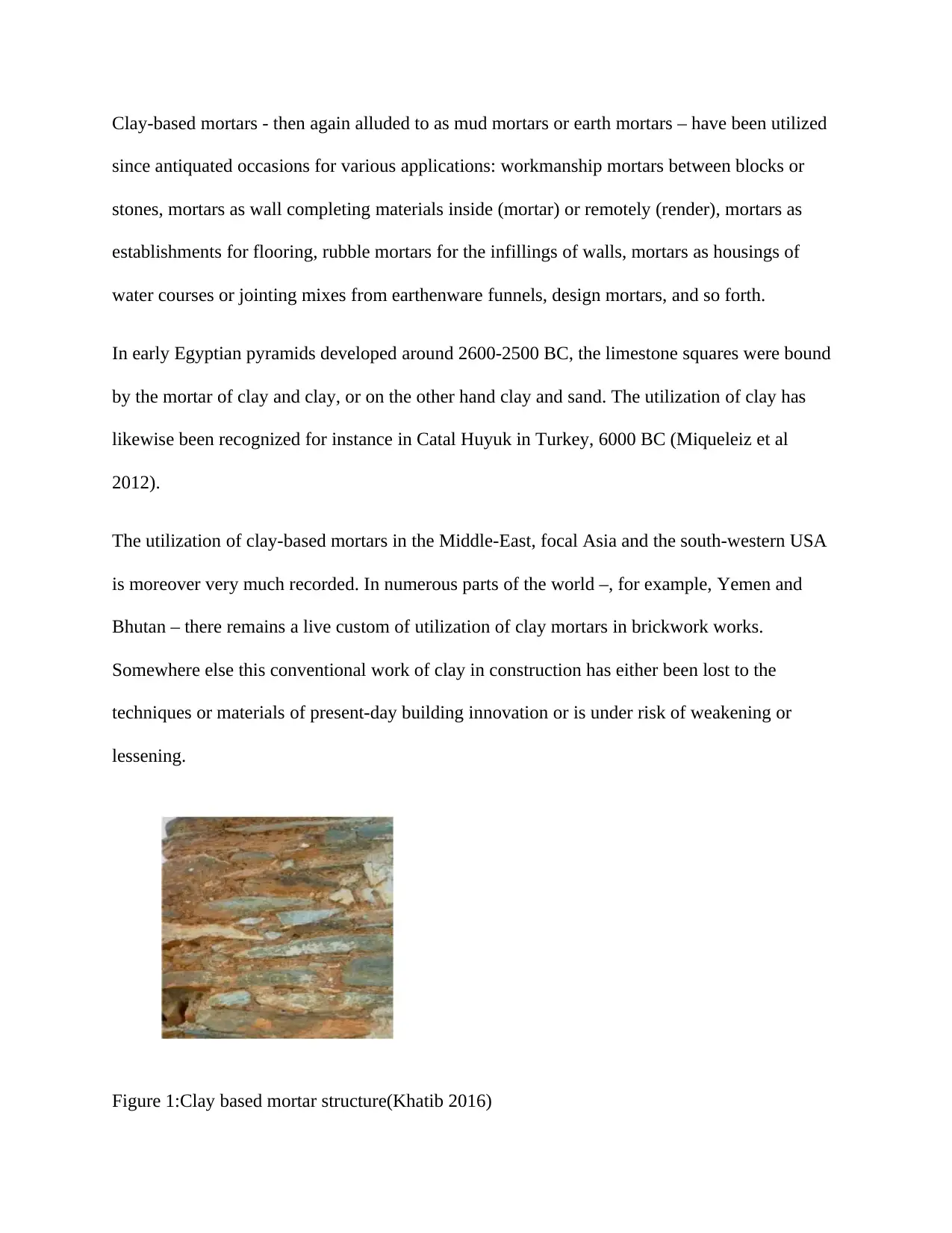
Clay-based mortars - then again alluded to as mud mortars or earth mortars – have been utilized
since antiquated occasions for various applications: workmanship mortars between blocks or
stones, mortars as wall completing materials inside (mortar) or remotely (render), mortars as
establishments for flooring, rubble mortars for the infillings of walls, mortars as housings of
water courses or jointing mixes from earthenware funnels, design mortars, and so forth.
In early Egyptian pyramids developed around 2600-2500 BC, the limestone squares were bound
by the mortar of clay and clay, or on the other hand clay and sand. The utilization of clay has
likewise been recognized for instance in Catal Huyuk in Turkey, 6000 BC (Miqueleiz et al
2012).
The utilization of clay-based mortars in the Middle-East, focal Asia and the south-western USA
is moreover very much recorded. In numerous parts of the world –, for example, Yemen and
Bhutan – there remains a live custom of utilization of clay mortars in brickwork works.
Somewhere else this conventional work of clay in construction has either been lost to the
techniques or materials of present-day building innovation or is under risk of weakening or
lessening.
Figure 1:Clay based mortar structure(Khatib 2016)
since antiquated occasions for various applications: workmanship mortars between blocks or
stones, mortars as wall completing materials inside (mortar) or remotely (render), mortars as
establishments for flooring, rubble mortars for the infillings of walls, mortars as housings of
water courses or jointing mixes from earthenware funnels, design mortars, and so forth.
In early Egyptian pyramids developed around 2600-2500 BC, the limestone squares were bound
by the mortar of clay and clay, or on the other hand clay and sand. The utilization of clay has
likewise been recognized for instance in Catal Huyuk in Turkey, 6000 BC (Miqueleiz et al
2012).
The utilization of clay-based mortars in the Middle-East, focal Asia and the south-western USA
is moreover very much recorded. In numerous parts of the world –, for example, Yemen and
Bhutan – there remains a live custom of utilization of clay mortars in brickwork works.
Somewhere else this conventional work of clay in construction has either been lost to the
techniques or materials of present-day building innovation or is under risk of weakening or
lessening.
Figure 1:Clay based mortar structure(Khatib 2016)
⊘ This is a preview!⊘
Do you want full access?
Subscribe today to unlock all pages.

Trusted by 1+ million students worldwide
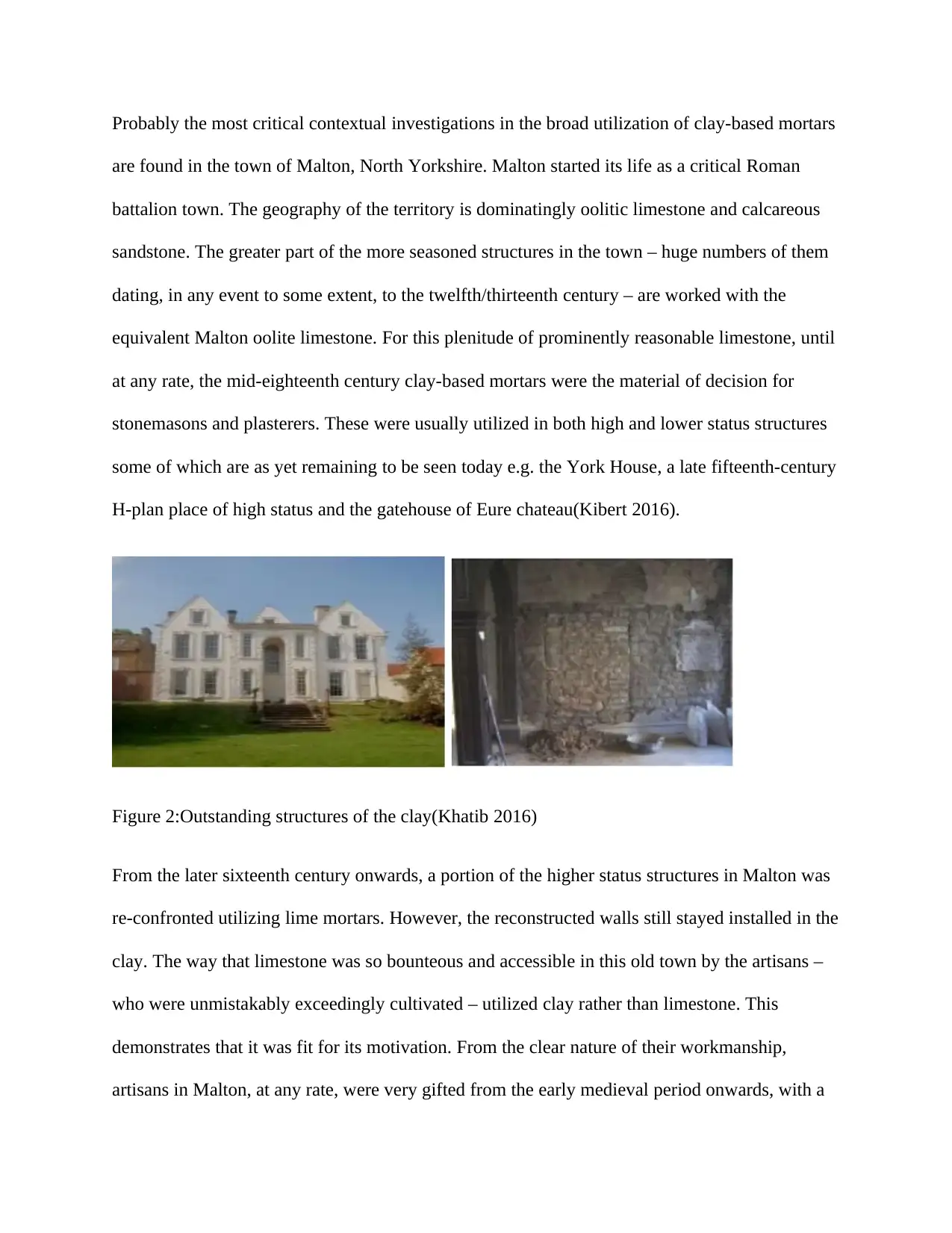
Probably the most critical contextual investigations in the broad utilization of clay-based mortars
are found in the town of Malton, North Yorkshire. Malton started its life as a critical Roman
battalion town. The geography of the territory is dominatingly oolitic limestone and calcareous
sandstone. The greater part of the more seasoned structures in the town – huge numbers of them
dating, in any event to some extent, to the twelfth/thirteenth century – are worked with the
equivalent Malton oolite limestone. For this plenitude of prominently reasonable limestone, until
at any rate, the mid-eighteenth century clay-based mortars were the material of decision for
stonemasons and plasterers. These were usually utilized in both high and lower status structures
some of which are as yet remaining to be seen today e.g. the York House, a late fifteenth-century
H-plan place of high status and the gatehouse of Eure chateau(Kibert 2016).
Figure 2:Outstanding structures of the clay(Khatib 2016)
From the later sixteenth century onwards, a portion of the higher status structures in Malton was
re-confronted utilizing lime mortars. However, the reconstructed walls still stayed installed in the
clay. The way that limestone was so bounteous and accessible in this old town by the artisans –
who were unmistakably exceedingly cultivated – utilized clay rather than limestone. This
demonstrates that it was fit for its motivation. From the clear nature of their workmanship,
artisans in Malton, at any rate, were very gifted from the early medieval period onwards, with a
are found in the town of Malton, North Yorkshire. Malton started its life as a critical Roman
battalion town. The geography of the territory is dominatingly oolitic limestone and calcareous
sandstone. The greater part of the more seasoned structures in the town – huge numbers of them
dating, in any event to some extent, to the twelfth/thirteenth century – are worked with the
equivalent Malton oolite limestone. For this plenitude of prominently reasonable limestone, until
at any rate, the mid-eighteenth century clay-based mortars were the material of decision for
stonemasons and plasterers. These were usually utilized in both high and lower status structures
some of which are as yet remaining to be seen today e.g. the York House, a late fifteenth-century
H-plan place of high status and the gatehouse of Eure chateau(Kibert 2016).
Figure 2:Outstanding structures of the clay(Khatib 2016)
From the later sixteenth century onwards, a portion of the higher status structures in Malton was
re-confronted utilizing lime mortars. However, the reconstructed walls still stayed installed in the
clay. The way that limestone was so bounteous and accessible in this old town by the artisans –
who were unmistakably exceedingly cultivated – utilized clay rather than limestone. This
demonstrates that it was fit for its motivation. From the clear nature of their workmanship,
artisans in Malton, at any rate, were very gifted from the early medieval period onwards, with a
Paraphrase This Document
Need a fresh take? Get an instant paraphrase of this document with our AI Paraphraser
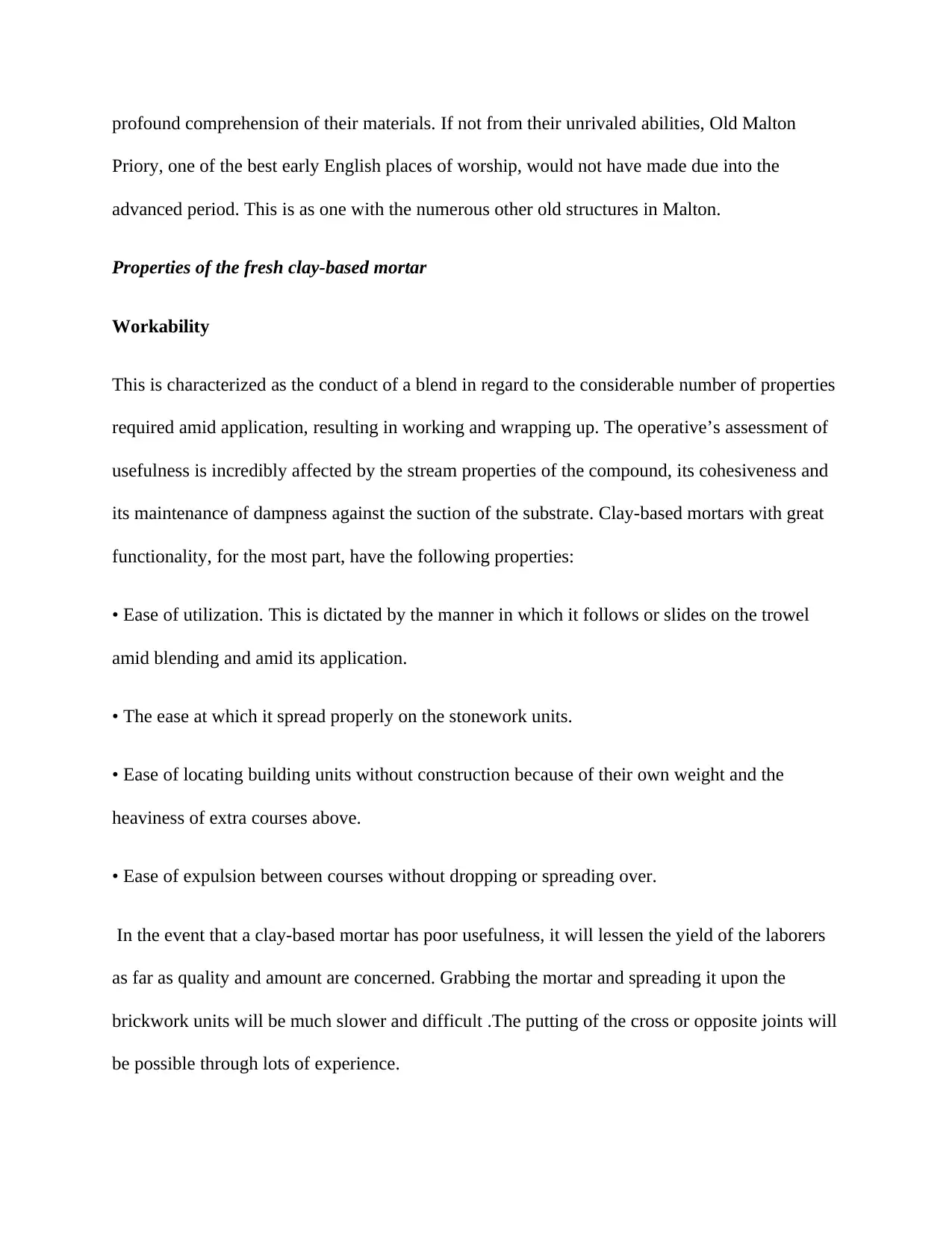
profound comprehension of their materials. If not from their unrivaled abilities, Old Malton
Priory, one of the best early English places of worship, would not have made due into the
advanced period. This is as one with the numerous other old structures in Malton.
Properties of the fresh clay-based mortar
Workability
This is characterized as the conduct of a blend in regard to the considerable number of properties
required amid application, resulting in working and wrapping up. The operative’s assessment of
usefulness is incredibly affected by the stream properties of the compound, its cohesiveness and
its maintenance of dampness against the suction of the substrate. Clay-based mortars with great
functionality, for the most part, have the following properties:
• Ease of utilization. This is dictated by the manner in which it follows or slides on the trowel
amid blending and amid its application.
• The ease at which it spread properly on the stonework units.
• Ease of locating building units without construction because of their own weight and the
heaviness of extra courses above.
• Ease of expulsion between courses without dropping or spreading over.
In the event that a clay-based mortar has poor usefulness, it will lessen the yield of the laborers
as far as quality and amount are concerned. Grabbing the mortar and spreading it upon the
brickwork units will be much slower and difficult .The putting of the cross or opposite joints will
be possible through lots of experience.
Priory, one of the best early English places of worship, would not have made due into the
advanced period. This is as one with the numerous other old structures in Malton.
Properties of the fresh clay-based mortar
Workability
This is characterized as the conduct of a blend in regard to the considerable number of properties
required amid application, resulting in working and wrapping up. The operative’s assessment of
usefulness is incredibly affected by the stream properties of the compound, its cohesiveness and
its maintenance of dampness against the suction of the substrate. Clay-based mortars with great
functionality, for the most part, have the following properties:
• Ease of utilization. This is dictated by the manner in which it follows or slides on the trowel
amid blending and amid its application.
• The ease at which it spread properly on the stonework units.
• Ease of locating building units without construction because of their own weight and the
heaviness of extra courses above.
• Ease of expulsion between courses without dropping or spreading over.
In the event that a clay-based mortar has poor usefulness, it will lessen the yield of the laborers
as far as quality and amount are concerned. Grabbing the mortar and spreading it upon the
brickwork units will be much slower and difficult .The putting of the cross or opposite joints will
be possible through lots of experience.
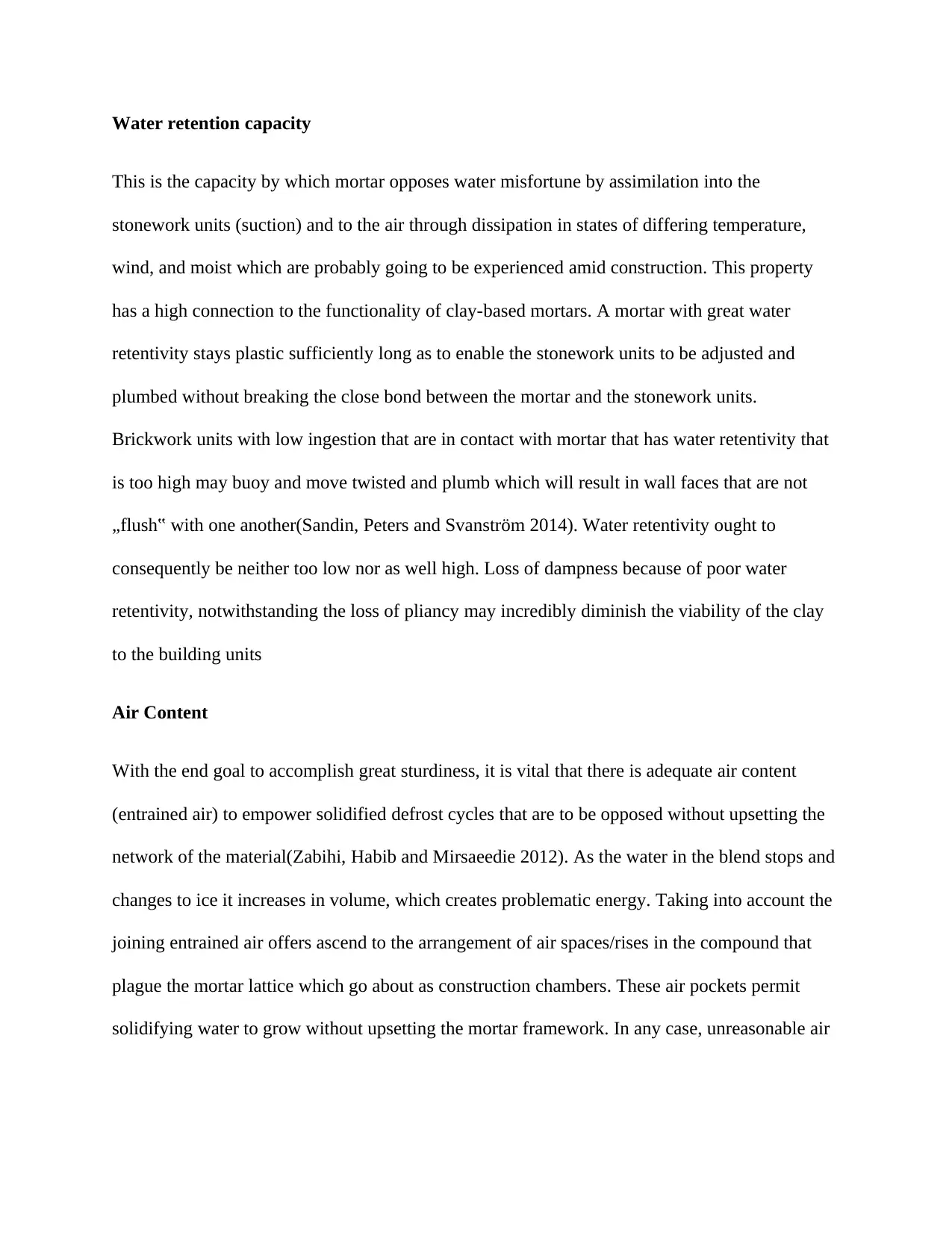
Water retention capacity
This is the capacity by which mortar opposes water misfortune by assimilation into the
stonework units (suction) and to the air through dissipation in states of differing temperature,
wind, and moist which are probably going to be experienced amid construction. This property
has a high connection to the functionality of clay-based mortars. A mortar with great water
retentivity stays plastic sufficiently long as to enable the stonework units to be adjusted and
plumbed without breaking the close bond between the mortar and the stonework units.
Brickwork units with low ingestion that are in contact with mortar that has water retentivity that
is too high may buoy and move twisted and plumb which will result in wall faces that are not
„flush‟ with one another(Sandin, Peters and Svanström 2014). Water retentivity ought to
consequently be neither too low nor as well high. Loss of dampness because of poor water
retentivity, notwithstanding the loss of pliancy may incredibly diminish the viability of the clay
to the building units
Air Content
With the end goal to accomplish great sturdiness, it is vital that there is adequate air content
(entrained air) to empower solidified defrost cycles that are to be opposed without upsetting the
network of the material(Zabihi, Habib and Mirsaeedie 2012). As the water in the blend stops and
changes to ice it increases in volume, which creates problematic energy. Taking into account the
joining entrained air offers ascend to the arrangement of air spaces/rises in the compound that
plague the mortar lattice which go about as construction chambers. These air pockets permit
solidifying water to grow without upsetting the mortar framework. In any case, unreasonable air
This is the capacity by which mortar opposes water misfortune by assimilation into the
stonework units (suction) and to the air through dissipation in states of differing temperature,
wind, and moist which are probably going to be experienced amid construction. This property
has a high connection to the functionality of clay-based mortars. A mortar with great water
retentivity stays plastic sufficiently long as to enable the stonework units to be adjusted and
plumbed without breaking the close bond between the mortar and the stonework units.
Brickwork units with low ingestion that are in contact with mortar that has water retentivity that
is too high may buoy and move twisted and plumb which will result in wall faces that are not
„flush‟ with one another(Sandin, Peters and Svanström 2014). Water retentivity ought to
consequently be neither too low nor as well high. Loss of dampness because of poor water
retentivity, notwithstanding the loss of pliancy may incredibly diminish the viability of the clay
to the building units
Air Content
With the end goal to accomplish great sturdiness, it is vital that there is adequate air content
(entrained air) to empower solidified defrost cycles that are to be opposed without upsetting the
network of the material(Zabihi, Habib and Mirsaeedie 2012). As the water in the blend stops and
changes to ice it increases in volume, which creates problematic energy. Taking into account the
joining entrained air offers ascend to the arrangement of air spaces/rises in the compound that
plague the mortar lattice which go about as construction chambers. These air pockets permit
solidifying water to grow without upsetting the mortar framework. In any case, unreasonable air
⊘ This is a preview!⊘
Do you want full access?
Subscribe today to unlock all pages.

Trusted by 1+ million students worldwide
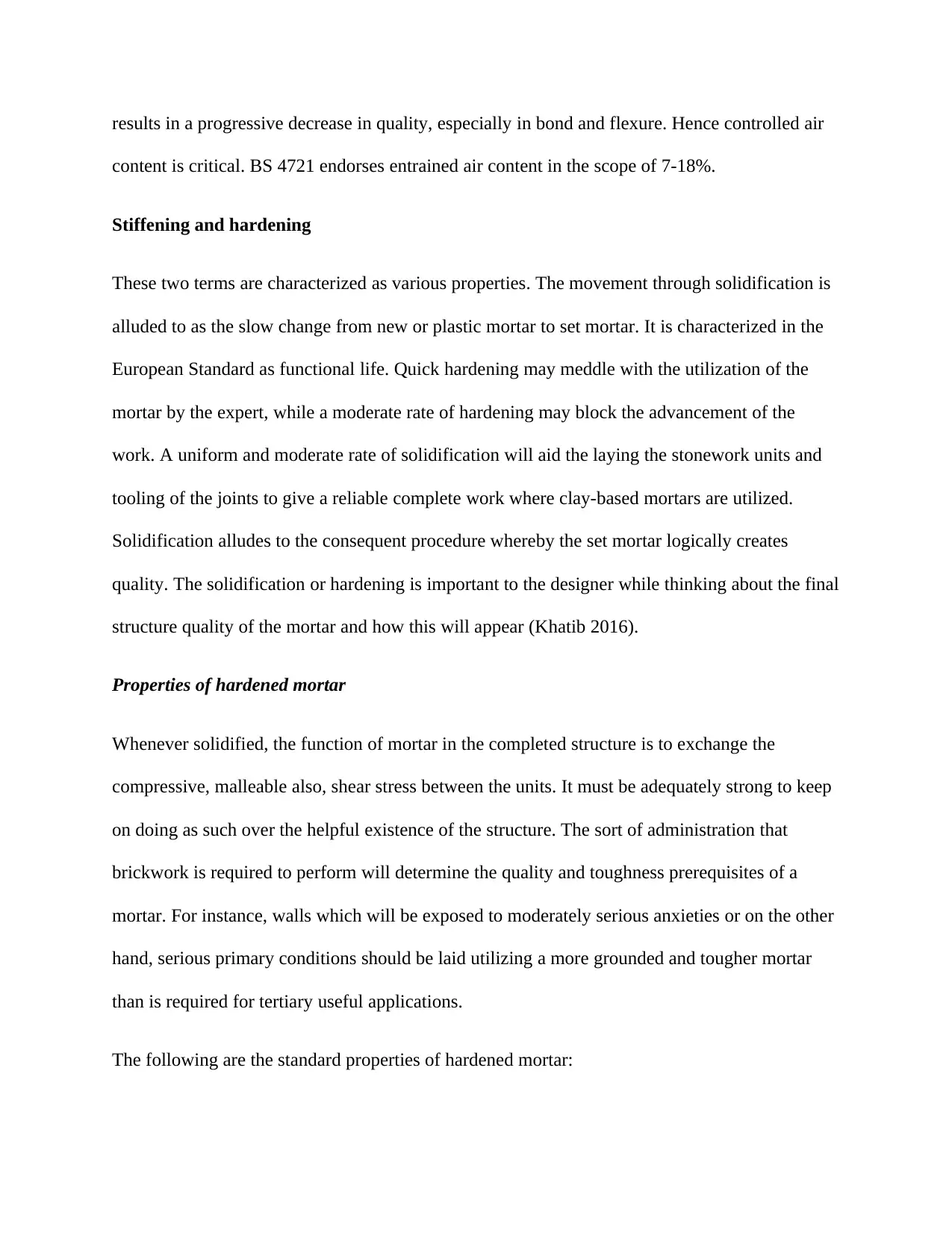
results in a progressive decrease in quality, especially in bond and flexure. Hence controlled air
content is critical. BS 4721 endorses entrained air content in the scope of 7-18%.
Stiffening and hardening
These two terms are characterized as various properties. The movement through solidification is
alluded to as the slow change from new or plastic mortar to set mortar. It is characterized in the
European Standard as functional life. Quick hardening may meddle with the utilization of the
mortar by the expert, while a moderate rate of hardening may block the advancement of the
work. A uniform and moderate rate of solidification will aid the laying the stonework units and
tooling of the joints to give a reliable complete work where clay-based mortars are utilized.
Solidification alludes to the consequent procedure whereby the set mortar logically creates
quality. The solidification or hardening is important to the designer while thinking about the final
structure quality of the mortar and how this will appear (Khatib 2016).
Properties of hardened mortar
Whenever solidified, the function of mortar in the completed structure is to exchange the
compressive, malleable also, shear stress between the units. It must be adequately strong to keep
on doing as such over the helpful existence of the structure. The sort of administration that
brickwork is required to perform will determine the quality and toughness prerequisites of a
mortar. For instance, walls which will be exposed to moderately serious anxieties or on the other
hand, serious primary conditions should be laid utilizing a more grounded and tougher mortar
than is required for tertiary useful applications.
The following are the standard properties of hardened mortar:
content is critical. BS 4721 endorses entrained air content in the scope of 7-18%.
Stiffening and hardening
These two terms are characterized as various properties. The movement through solidification is
alluded to as the slow change from new or plastic mortar to set mortar. It is characterized in the
European Standard as functional life. Quick hardening may meddle with the utilization of the
mortar by the expert, while a moderate rate of hardening may block the advancement of the
work. A uniform and moderate rate of solidification will aid the laying the stonework units and
tooling of the joints to give a reliable complete work where clay-based mortars are utilized.
Solidification alludes to the consequent procedure whereby the set mortar logically creates
quality. The solidification or hardening is important to the designer while thinking about the final
structure quality of the mortar and how this will appear (Khatib 2016).
Properties of hardened mortar
Whenever solidified, the function of mortar in the completed structure is to exchange the
compressive, malleable also, shear stress between the units. It must be adequately strong to keep
on doing as such over the helpful existence of the structure. The sort of administration that
brickwork is required to perform will determine the quality and toughness prerequisites of a
mortar. For instance, walls which will be exposed to moderately serious anxieties or on the other
hand, serious primary conditions should be laid utilizing a more grounded and tougher mortar
than is required for tertiary useful applications.
The following are the standard properties of hardened mortar:
Paraphrase This Document
Need a fresh take? Get an instant paraphrase of this document with our AI Paraphraser
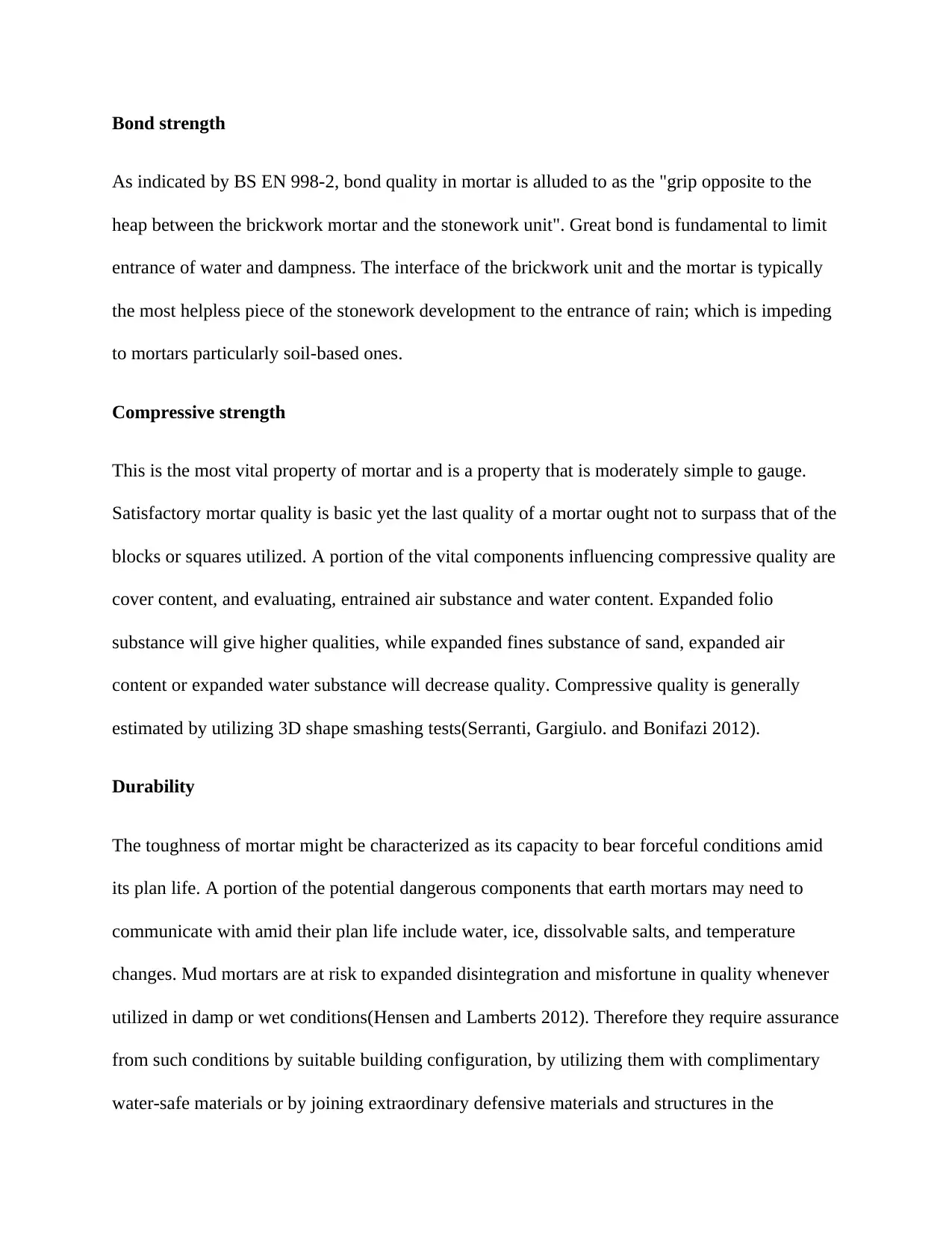
Bond strength
As indicated by BS EN 998-2, bond quality in mortar is alluded to as the "grip opposite to the
heap between the brickwork mortar and the stonework unit". Great bond is fundamental to limit
entrance of water and dampness. The interface of the brickwork unit and the mortar is typically
the most helpless piece of the stonework development to the entrance of rain; which is impeding
to mortars particularly soil-based ones.
Compressive strength
This is the most vital property of mortar and is a property that is moderately simple to gauge.
Satisfactory mortar quality is basic yet the last quality of a mortar ought not to surpass that of the
blocks or squares utilized. A portion of the vital components influencing compressive quality are
cover content, and evaluating, entrained air substance and water content. Expanded folio
substance will give higher qualities, while expanded fines substance of sand, expanded air
content or expanded water substance will decrease quality. Compressive quality is generally
estimated by utilizing 3D shape smashing tests(Serranti, Gargiulo. and Bonifazi 2012).
Durability
The toughness of mortar might be characterized as its capacity to bear forceful conditions amid
its plan life. A portion of the potential dangerous components that earth mortars may need to
communicate with amid their plan life include water, ice, dissolvable salts, and temperature
changes. Mud mortars are at risk to expanded disintegration and misfortune in quality whenever
utilized in damp or wet conditions(Hensen and Lamberts 2012). Therefore they require assurance
from such conditions by suitable building configuration, by utilizing them with complimentary
water-safe materials or by joining extraordinary defensive materials and structures in the
As indicated by BS EN 998-2, bond quality in mortar is alluded to as the "grip opposite to the
heap between the brickwork mortar and the stonework unit". Great bond is fundamental to limit
entrance of water and dampness. The interface of the brickwork unit and the mortar is typically
the most helpless piece of the stonework development to the entrance of rain; which is impeding
to mortars particularly soil-based ones.
Compressive strength
This is the most vital property of mortar and is a property that is moderately simple to gauge.
Satisfactory mortar quality is basic yet the last quality of a mortar ought not to surpass that of the
blocks or squares utilized. A portion of the vital components influencing compressive quality are
cover content, and evaluating, entrained air substance and water content. Expanded folio
substance will give higher qualities, while expanded fines substance of sand, expanded air
content or expanded water substance will decrease quality. Compressive quality is generally
estimated by utilizing 3D shape smashing tests(Serranti, Gargiulo. and Bonifazi 2012).
Durability
The toughness of mortar might be characterized as its capacity to bear forceful conditions amid
its plan life. A portion of the potential dangerous components that earth mortars may need to
communicate with amid their plan life include water, ice, dissolvable salts, and temperature
changes. Mud mortars are at risk to expanded disintegration and misfortune in quality whenever
utilized in damp or wet conditions(Hensen and Lamberts 2012). Therefore they require assurance
from such conditions by suitable building configuration, by utilizing them with complimentary
water-safe materials or by joining extraordinary defensive materials and structures in the
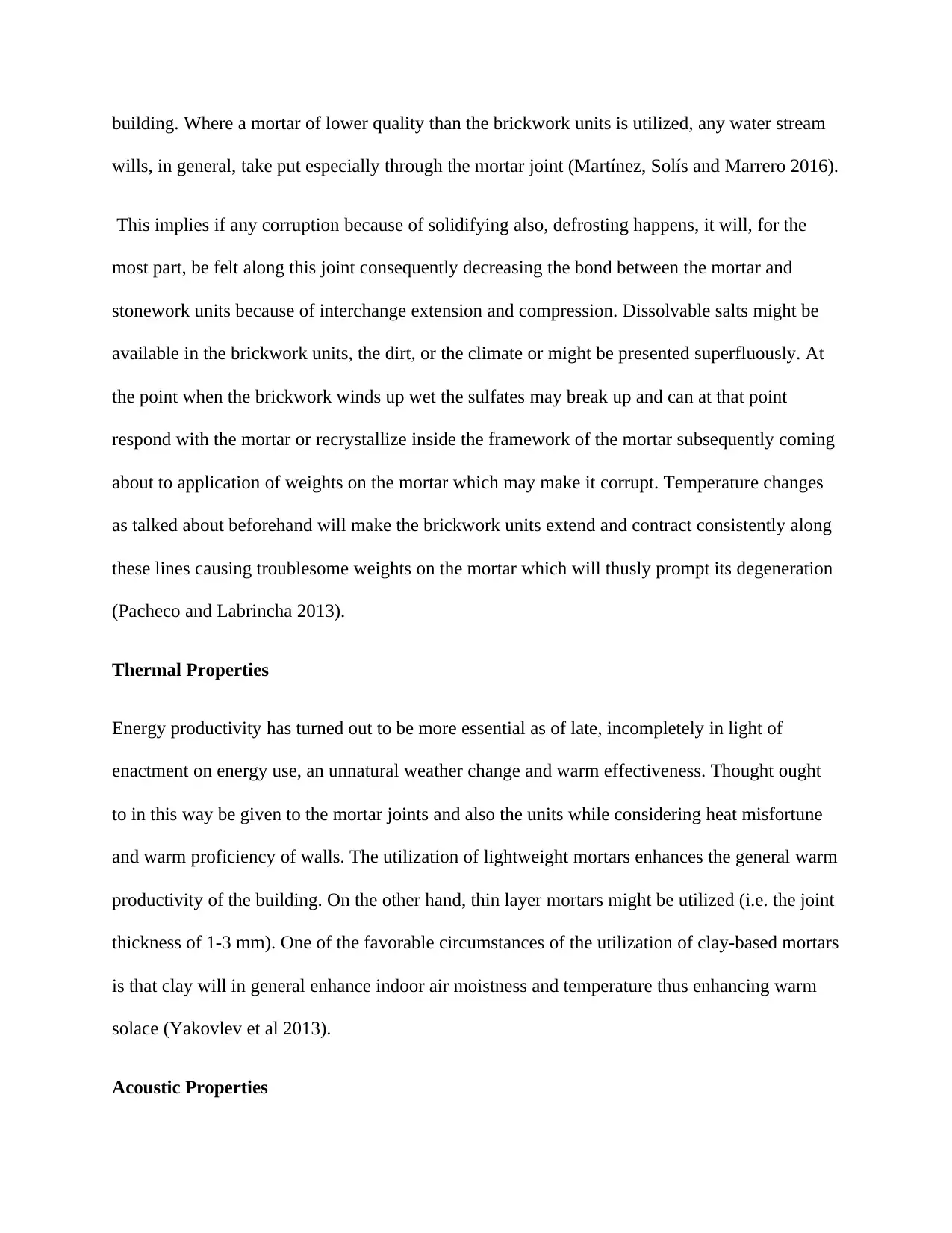
building. Where a mortar of lower quality than the brickwork units is utilized, any water stream
wills, in general, take put especially through the mortar joint (Martínez, Solís and Marrero 2016).
This implies if any corruption because of solidifying also, defrosting happens, it will, for the
most part, be felt along this joint consequently decreasing the bond between the mortar and
stonework units because of interchange extension and compression. Dissolvable salts might be
available in the brickwork units, the dirt, or the climate or might be presented superfluously. At
the point when the brickwork winds up wet the sulfates may break up and can at that point
respond with the mortar or recrystallize inside the framework of the mortar subsequently coming
about to application of weights on the mortar which may make it corrupt. Temperature changes
as talked about beforehand will make the brickwork units extend and contract consistently along
these lines causing troublesome weights on the mortar which will thusly prompt its degeneration
(Pacheco and Labrincha 2013).
Thermal Properties
Energy productivity has turned out to be more essential as of late, incompletely in light of
enactment on energy use, an unnatural weather change and warm effectiveness. Thought ought
to in this way be given to the mortar joints and also the units while considering heat misfortune
and warm proficiency of walls. The utilization of lightweight mortars enhances the general warm
productivity of the building. On the other hand, thin layer mortars might be utilized (i.e. the joint
thickness of 1-3 mm). One of the favorable circumstances of the utilization of clay-based mortars
is that clay will in general enhance indoor air moistness and temperature thus enhancing warm
solace (Yakovlev et al 2013).
Acoustic Properties
wills, in general, take put especially through the mortar joint (Martínez, Solís and Marrero 2016).
This implies if any corruption because of solidifying also, defrosting happens, it will, for the
most part, be felt along this joint consequently decreasing the bond between the mortar and
stonework units because of interchange extension and compression. Dissolvable salts might be
available in the brickwork units, the dirt, or the climate or might be presented superfluously. At
the point when the brickwork winds up wet the sulfates may break up and can at that point
respond with the mortar or recrystallize inside the framework of the mortar subsequently coming
about to application of weights on the mortar which may make it corrupt. Temperature changes
as talked about beforehand will make the brickwork units extend and contract consistently along
these lines causing troublesome weights on the mortar which will thusly prompt its degeneration
(Pacheco and Labrincha 2013).
Thermal Properties
Energy productivity has turned out to be more essential as of late, incompletely in light of
enactment on energy use, an unnatural weather change and warm effectiveness. Thought ought
to in this way be given to the mortar joints and also the units while considering heat misfortune
and warm proficiency of walls. The utilization of lightweight mortars enhances the general warm
productivity of the building. On the other hand, thin layer mortars might be utilized (i.e. the joint
thickness of 1-3 mm). One of the favorable circumstances of the utilization of clay-based mortars
is that clay will in general enhance indoor air moistness and temperature thus enhancing warm
solace (Yakovlev et al 2013).
Acoustic Properties
⊘ This is a preview!⊘
Do you want full access?
Subscribe today to unlock all pages.

Trusted by 1+ million students worldwide
1 out of 21
Your All-in-One AI-Powered Toolkit for Academic Success.
+13062052269
info@desklib.com
Available 24*7 on WhatsApp / Email
![[object Object]](/_next/static/media/star-bottom.7253800d.svg)
Unlock your academic potential
Copyright © 2020–2025 A2Z Services. All Rights Reserved. Developed and managed by ZUCOL.


